Closing Thoughts:
To summarise, the cooling performance of the Cooler Master ML360 Sub-Zero is excellent under low-power conditions such as lightly-threaded workloads for hefty K-series CPUs.
Lightly-threaded workloads on a 10-core chip is clearly an oxy-moron. However, we did see sub-ambient temperatures in the sensible ‘Cryo’ mode as well as a 0°C reading in the more extreme ‘Unregulated’ mode – which is cool to observe.
As soon as the cooling requirements are increased to anywhere near the reasonable – for today’s CPUs – 200W level, the Sub-Zero’s performance falls off a cliff. Even the motherboard vendor’s aggressive ‘stock’ multi-core turbo levels were unstable and resulted in quick thermal throttling at 99C. And that is despite a 360mm Asetek AIO registering sub-75C readings after a half-hour run of the same test.
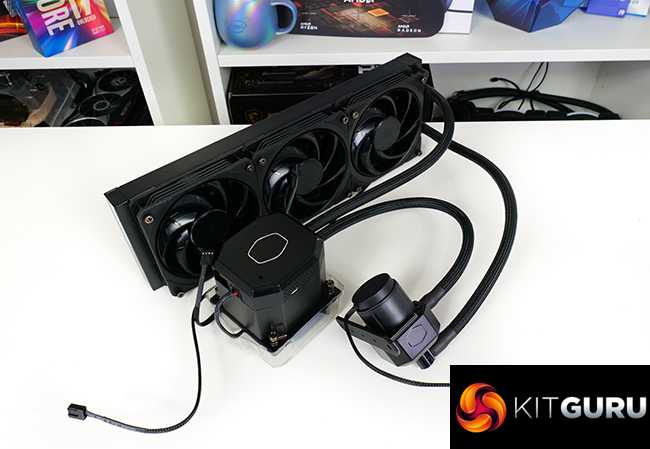
Put simply, the ML360 Sub-Zero is a pretty weird toy created by Cooler Master and Intel to demonstrate the potential benefits and use cases of TEC hardware and Intel’s Cryo Cooling technology. Yes, there are some viable use cases – such as pushing for ridiculous single-core frequencies of 5.5GHz or 5.6GHz as in our testing.
But even then, the benefits aren’t a given as Zen 3 still offers higher single-thread performance and some AAA games such as Shadow of the Tomb Raider demand more CPU package power than the cooler can actually deal with.
The reality is that this cooler is more of a novelty item than something a real-world user should actually consider buying. That’s especially true with the ludicrous £340 price tag, poor compatibility, noticeable noise levels, and potentially extreme power draw under heavy load situations.
It is certainly not something we will be recommending anytime soon. But it was a cool piece of kit to play with that could perhaps mature somewhat going forward. And it did help us validate some of the benefits of Intel’s Thermal Velocity Boost Overclocking which is solid, even if AMD’s Precision Boost algorithm still seems to be more advanced and less complicated for average users.
The Cooler Master MasterLiquid ML360 Sub-Zero is priced at £339.95 at Overclockers UK.
Discuss on our Facebook page HERE.
Pros:
- Sub-ambient cooling capability.
- Ability to register 0°C for a Core i9-10900K.
- Decent cooling capacity below around 125W.
- Good lightly-threaded cooling potential.
- Can work well with Intel Thermal Velocity Boost Overclocking.
Cons:
- Very poor performance at higher power loads typical of Intel K processors.
- Ludicrously expensive for the performance.
- Significant power usage.
- Only LGA1200 compatibility.
- High noise output from the pump.
KitGuru says: A cool toy to test out sub-ambient cooling with TEC technology. The implementation definitely needs to mature before even considering a purchase though.
COOLER MASTER MASTERLIQUID ML360 SUB-ZERO CPU LIQUID COOLER (MLZ-D36M-A19PK-12)
The MasterLiquid ML360 Sub-Zero powered by Intel? Cryo Cooling Technology delivers a cooling solution unlike that of your traditional thermal solutions. Allowing the processor to be able to reach higher frequencies at lower voltages due to behavioral characteristics of silicon that can only be achieved through sub-ambient temperatures. Utilizing the unique combination of hardware, software and firmware to push the thermal limitations of your processor.
ML360 SUB-ZERO POWERED INTEL??CRYO COOLING TECHNOLOGY
?The MASTERLIQUID ML360 SUB-ZERO cooler is exclusively powered by Intel Cryo Cooling Technology, a unique combination of hardware, software, and firmware designed to help unleash elite performance for gamers, overclockers, and content creators.?
AGE OF CRYO-CLOCKING
Playing with the properties of Silicon to deliver a more optimized way to achieve over-clocking but not in the traditional sense. Unlike using solutions such as liquid nitrogen, the Sub-Zero is designed to allow gamers and content creators to achieve those higher frequencies while giving off less heat and ability to run at high frequencies as usual while using less power.
The ML360 Sub-Zero pushes the thermal boundaries of standard cooling solutions while adapting to the limitations of being a closed loop liquid cooler. This will allow for maximum potential of your CPU to realized, especially during low core count OC that can only be done with sub-ambient cooling. Cryo-Clocking pushes the frontier on innovation by introducing a sub-ambient cooling solution, unique in design and technology driven.
KEY FEATURES
- Sub-Ambient Cooling
Specifically designed using Thermoelectric Unit (TEC) to cool your processor and create the conditions that allow it to achieve low core count over-clocking.
- Powered by Intel Cryo Cooling Technology
Designed with a simple user interface making it easy to understand and control the sub-ambient cooling potential.
- Cryo-Clocking
Silicon can reach higher frequencies at lower voltages that can only be achieved through sub-ambient cooling. The concept of Cryo-Clocking is to push?the performance of the CPU to reach maximum capacity within the limits.
- 2nd Generation Pump
Enhanced pump delivers higher liquid flow for exceptional heat removal.
360 MM RADIATOR WITH SF120R FANS
High Performance Air Balance fans designed to spin at low rpm with great air pressure to air flow ratio. With a 360 radiator to dissipate heat efficiently.
?SPECIFICALLY DESIGNED WATER BLOCK
- The circuit board features built in sensors for temperature and dew point to help minimize the effects of condensation.
- 52x52mm TEC unit is built-in to the water block to cool you CPU.
- Sensors communicate temperature and humidity conditions back to the system.
- This seal maintains steady processing performance, as well as preventing condensation and external elements to protect your system.
IMPROVED AND ENHANCED PUMP
Newly Designed Pump traditionally used in DIY cooling systems with high performance motor that has an enhanced repeller to dissipated heat from the TEC in a more efficiently.
Front Mounted Pump
To get the best performance for your system for you CPU we recommend a top installation of the 360mm radiator and a front installation of the pump. The fans are pre-installed on the radiator and pump bracket pre-attached (out-of-box).
SETTING UP OVERCLOCKING ON YOUR CPU
Overclocking your CPU doesn?t have to be complicated and can be achieved in 2 basic ways:
Overclocking through BIOS Settings
OR
Using Intel XTU Software
(For more info on downloading and setting up XTU software, click the link below)
Intel Cryo Cooling Technology
What makes the Intel Cryo Cooling Technology so interesting? Well, a couple of things actually.
First, the Intel Cryo Cooling Technology offers a software solution to control the Peltier temperature.
In Cryo mode, the Peltier element inside the Intel Cryo Cooling Technology enabled product is only switched on when required and is switched off when not required. This greatly reduces the overall power consumed as the TEC is not running at full power all the time. The Intel software regulates the cooler temperature by assessing the humidity in the room as well as the CPU temperature. Based on this input, the software ensures that maximum cooling is provided at any time while ensuring the temperature does not drop below the dew point and cause condensation issues. This mode is indicated by a green icon in the desktop tray and a green LED on the TEC controller.
In Unregulated mode, the Intel Cryo Cooling Technology enabled product cools well below ambient temperature with less protection from condensation. In this mode there will be condensation risk on the heatsink surfaces and surroundings due to the low temperature. It can cause system damage. This mode is indicated by a white icon in the desktop tray and a purple LED on the TEC controller.
Second, the Intel controller also measures the humidity in the room. Based on this input, the controller can adjust the TEC temperature to always be above the dew point. This helps to avoid any condensation issues.
Third, it maximizes the impact of the Intel Thermal Velocity Boost feature by ensuring best-case operating temperatures. Using Thermal Velocity Boost also allows us opportunistically benefit from the added frequency range as the frequency adjusts based on when we really need it.
All things combined, the Intel Cryo Cooling Technology is arguably be the most advanced and well-rounded implementation of thermoelectric cooling for enthusiasts to date. It is available in two products: EK-QuantumX Delta TEC and Cooler Master MasterLiquid ML360 Sub-Zero.
Thermo-Electric Cooling
The Intel Cryo Cooling Technology is built around the thermoelectric effect. Simply put, the thermoelectric effect is the conversion of differences in temperature to an electric voltage and vice versa. In the PC enthusiast space it is best known as Peltier cooling.
The Peltier effect creates a temperature difference by transferring heat between two electrical junctions. A voltage is applied across joined conductors to create an electric current. When the current flows through the junctions of the two conductors, heat is removed at one junction and cooling occurs. Heat is deposited at the other junction.
Simply put: more voltage makes one side go “haaa” and the other side go “brrrr”.
The main advantage of Peltier cooling for PC enthusiasts is that it allows you to get sub-ambient temperatures. And as we all know, lower temperatures means higher overclocks.
Without going too deep in the what’s and why’s of TEC cooling, suffice to say it’s a technology that’s been around for over two decades and hasn’t really found any footing in the mainstream market. That’s because while the technology offers the clear advantage of superior cooling performance, there are also key disadvantages.
First, condensation. A Peltier cooler can produce a temperature difference of up to 70c between the hot and cold side. So, the cold side will be operating at a lower temperature than ambient. This will create condensation … which doesn’t mix well with electronics.
Second, efficiency. Peltier cooling consumes disproportionally high amounts of electrical energy for the heat it dissipates.
Third, cooling. In order to maximize the benefit of the Peltier you need to cool the hot side sufficiently. High performance Peltier units like the one included with the EK-QuantumX Delta are rated up to 200W which is significantly higher than a modern mainstream high-performance CPU like the 10900K which is rated up to 125W.
Lastly, control. Most Peltier coolers out there provide the user with no control over the cooling. So it’s either on or off, but no in between.
Testing Summaries:
Stock – 125W – Mode
For stock 125W testing, the performance is… OK, I guess. Sub-50C for a 125W 10900K isn’t bad but it’s only 125W. And 0C under idle conditions is really cool to see.
But let’s up the cooling demand.
Stock MCT Mode at around 200W+ package power
Stock multi-core turbo performance is very unimpressive as the cooler lets the CPU spiral to thermal throttling of 99C even after just a couple of minutes. This is simply too much power from the 10-core chip.
For reference, a Phanteks 360mm Asetek AIO scored under 75C for a 30-minute Cinebench R23 loop under the same Stock MCT settings. And CPU package power was 220W in that test.
So, very comparable conditions but far better cooling from a normal 360mm AIO. Heavy multi-core loads at elevated CPU clocks are clearly off the table with the Sub-Zero.
Let’s try some Thermal Velocity Boost overclocking with less strenuous, lightly-threaded workloads instead.
5.5-5.6GHz TVB Unregulated Mode
OK, so with some XTU tweaking and application of lightly-threaded workloads well below 125W CPU power draw, you can indeed get excellent temperatures for crazy high clock speeds. It’s not all that useful in the real world and still requires loads of cooling power though.
5.5GHz Sensible Cryo Mode
For reference, a 360mm Asetek AIO was around mid-to-high 50s CPU temp and over 70W package power when running the Cinebench 1T test using our 5.4GHz manual OC. Therefore, actual temps of the cooler in Cryo Mode here are pretty good.
Clearly a target such as 5.5GHz with the Cryo Mode running sensibly is better for power and still good for temps and clocks.
Games
It looks like some games are a light enough load to be able to handle ludicrously high frequencies under this cooler. If that’s what you’re interested in and you don’t care about the price or the downsides of the ML360 Sub-Zero, knock yourself out, I guess.
Noise
Looking at noise output, the cooler is undeniably loud when pushing the temperatures low. Our video review shows the noise meter hovering around 50 dBA which is well into audible and noticeable territory.
The fans are not particularly quiet and there is also a noticeable hum from the pump unit and a lack of speed control at least in the Intel Cryo software.
Specifications
The Cooler Master ML360 Sub-Zero looks the part of an ultra-high end cooling solution, with its sleek blacked-out design and a touch of opulence from the chromed Cooler Master silhouette logo across its brushed pump face. A single LED indicator light illuminates the lower corner of the pump housing, offering the working status of the cooler’s Peltier cooling system. HAL-9000 would be proud.
| Thickness | 1.10″ / 27.9mm (2.25″ / 57.15mm w/fans) |
| Width | 4.75″ / 120mm |
| Depth | 15.5″ / 394mm |
| Pump Height | 3.75″ / 95.3mm |
| Speed Controller | BIOS/Software |
| Cooling Fans | (3) 120 x 25mm |
| Connectors | (4) 4-Pin PWM, |
| (1) 3-Pin tach, | |
| (1) SATA | |
| Weight | 82.5 oz / 2340g |
| Intel Sockets | LGA1200 (only) |
| AMD Sockets | N/A |
| Warranty | 5 years |
| Web Price | $350 |
Test Procedure:
Our usual cooling test system is based around AMD’s Ryzen 9 5950X, but this is not a possibility with this cooler. As such, we run the ML360 Sub-Zero AIO with the best 10th/11th Gen CPU available in our opinion – the Core i9-10900K processor.
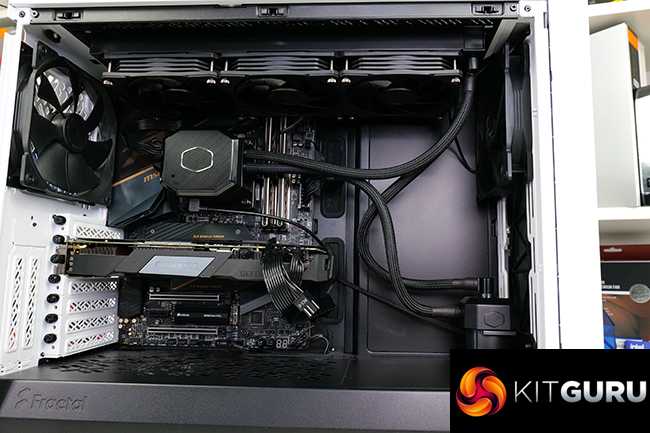
- Processor: Intel Core i9-10900K.
- Motherboard: MSI MEG Z490 ACE.
- Memory: 16GB (2x8GB) KLEVV 4000MHz DDR4.
- Graphics Card: Gigabyte RTX 2060 Super.
- Chassis: Fractal Meshify 2.
- Power Supply: Seasonic Prime TX-1000.
- SSD: Corsair MP600 NVMe M.2 SSD.
- Operating System: Windows 10 Pro 64-bit.
Typically, we would outline some test procedures and settings for comparisons against a barrage of other CPU coolers. However, that’s not possible in this review given the genuinely unique intended usage and performance behaviour of the ML360 Sub-Zero.
As such, we will instead be showing some of the cooling and performance characteristics using hands-on testing so that you can see how this cooler performs, including its victories and several quirks.
It is best to view the video analysis to understand how the CPU cooler behaves. We will summarise our findings for the individual test cases in this written review.
Seite 1: Cooler Master MasterLiquid ML360 Sub-Zero im Test: Mit Intels Cryo Cooling Technology zum OC-Erfolg?
Cooler Masters MasterLiquid ML360 Sub-Zero ist eine ganz besondere AiO-Kühlung. Denn durch die Nutzung von Intels Cryo Cooling Technology sollen Temperaturen unterhalb der Umgebungstemperatur erreicht — und Overclocking-Erfolge möglich gemacht werden.
Eine handelsübliche AiO-Kühlung mit 360-mm-Radiator kann zwar eine beachtliche Kühlleistung bieten, große Performancezuwächse sind aber eigentlich nicht mehr zu erwarten. Doch Cooler Masters MasterLiquid ML360 Sub-Zero ist keine gewöhnliche AiO-Kühlung. Denn dank Intels Cryo Cooling Technology sollen Temperaturen möglich sein, die unter der Umgebungstemperatur liegen. Davon darf man sich dann höhere Taktraten bei geringerer Spannung erhoffen. Interessant sein soll die MasterLiquid ML360 Sub-Zero damit vor allem für Nutzer, die beim Übertakten weiter als mit einer üblichen AiO-Kühlung gehen wollen.
Doch was verbirgt sich nun eigentlich hinter Intels Cryo Cooling Technology? Eigentlich ein alter Bekannter: Ein Peltier-Element bzw. TEC (engl. für thermoelectric cooler). Ein elektrothermischer Wandler erzeugt durch Stromdurchfluss eine Temperaturdifferenz. Allerdings sind Peltier-Elemente für ihren geringen Wirkungsgrad und entsprechend hohen Stromhunger bekannt. Auch die MasterLiquid ML360 Sub-Zero kann einen beachtlichen Stromverbrauch von bis zu 200 W erreichen. Anders als bei älteren Peltier-Kühllösungen soll bei Intels Cryo Cooling Technology aber eine Kombination von Hardware, Software und Firmware für eine möglichst optimale Abstimmung der Kühlung sorgen. Dabei soll auch ein Unterschreiten des Taupunkts und eine damit verbundene kritische Kondensation verhindert werden. Die Intel-Technologie wird vorerst für zwei Produkte genutzt: Die MasterLiquid ML360 Sub-Zero als AiO-Kühlung und den EK-QuantumX Delta TEC als Wasserkühler für DIY-Wasserkühlungen.
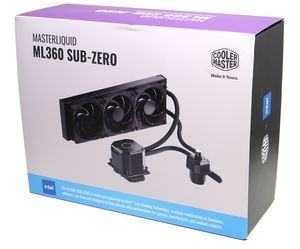
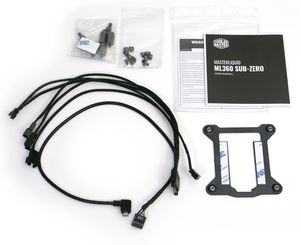
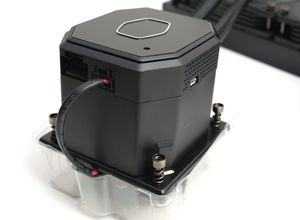
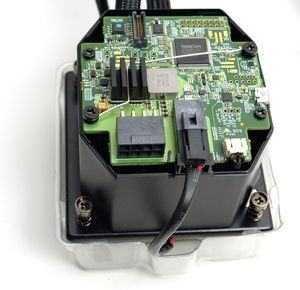
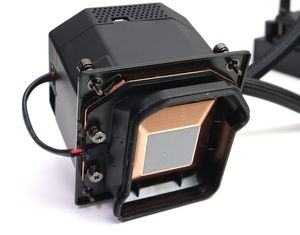
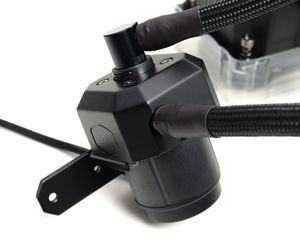
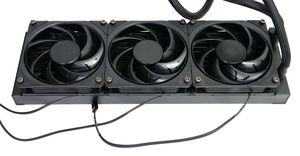
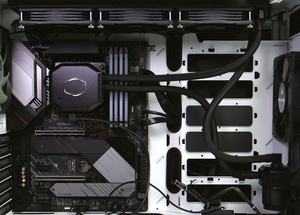
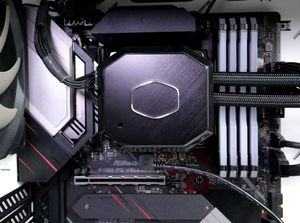
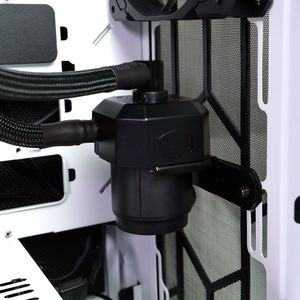
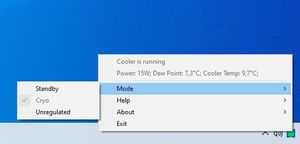
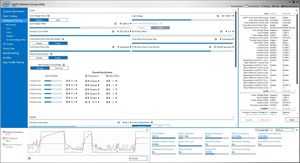
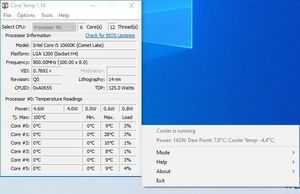
Gegenüber konventionellen AiO-Kühlungen mit 360-mm-Radiator wird die Cooler Master MasterLiquid ML360 Sub-Zero deutlich teurer: Der Handel listet sie für rund 350 Euro. Vor dem Kauf muss berücksichtigt werden, dass die TEC-AiO-Kühlung nur mit Montagematerial für Intels LGA 1200-Sockel ausgeliefert wird. Vorhanden sein sollte außerdem eine K-CPU mit freiem Multiplikator, ein geeignetes PC-Gehäuse und ein Netzteil, das den zusätzlichen Leistungsbedarf des Peltier-Elements verkraftet. Schließlich wird auch nur eine bestimmte Auswahl an LGA-1200-Mainboards empfohlen.
Im ausgepackt & angefasst-Video werfen wir einen ersten Blick auf die AiO-Kühlung:
Datenschutzhinweis für Youtube
An dieser Stelle möchten wir Ihnen ein Youtube-Video zeigen. Ihre Daten zu schützen, liegt uns aber am Herzen: Youtube setzt durch das Einbinden und Abspielen Cookies auf ihrem Rechner, mit welchen Sie eventuell getracked werden können. Wenn Sie dies zulassen möchten, klicken Sie einfach auf den Play-Button. Das Video wird anschließend geladen und danach abgespielt.
Ihr Hardwareluxx-Team Youtube Videos ab jetzt direkt anzeigen Video anzeigen
| Kühlername | Cooler Master MasterLiquid ML360 Sub-Zero (MLZ-D36M-A19PK-12) |
|---|---|
| Kaufpreis | rund 350 Euro |
| Homepage | www.coolermaster.com |
| Kühlertyp | All-in-One Wasserkühlung mit 360-mm-Radiator und Peltier-Element |
| Maße Radiator (ohne Lüfter) | 394 x 119,6 x 27,2 mm (L x B x H) |
| Material | Bodenplatte: Kupfer Radiator: Aluminium |
| Schläuche | textilummantelt |
| Serienbelüftung | drei 120-mm-PWM-Lüfter (SF120R), 650-1.900 U/min |
| Sockel | Intel LGA 1200 |
| Leistungsaufnahme | bis zu 200 W |
| Garantiedauer | fünf Jahre |
<>Cooler Master MasterLiquid ML360 Sub-Zero im Test: Mit Intels Cryo Cooling Technology zum OC-Erfolg?Detailbetrachtung (1)

























